Nymph
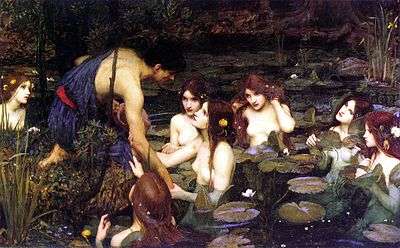 In this 1896 painting of Hylas and the Nymphs by John William Waterhouse, Hylas is abducted by the Naiads, i.e. fresh water nymphs | |
| Grouping | Mythological |
|---|---|
| Sub grouping | Nature spirit |
| Similar creatures | Mermaid, huldra, selkie, siren |
| Mythology | Greek mythology |
| Country | Greece |
| Habitat | Various |
A nymph (Greek: νύμφη, nýmphē [nýmpʰɛː]) in Greek mythology is a minor female nature deity typically associated with a particular location or landform.
Different from other goddesses, nymphs are generally regarded as divine spirits who animate nature, and are usually depicted as beautiful, young nubile maidens who love to dance and sing; their amorous freedom sets them apart from the restricted and chaste wives and daughters of the Greek polis. They are beloved by many and dwell in mountainous regions and forests by springs or rivers; as Walter Burkert (Burkert 1985:III.3.3) remarks, "The idea that rivers are gods and springs divine nymphs is deeply rooted not only in poetry but in belief and ritual; the worship of these deities is limited only by the fact that they are inseparably identified with a specific locality." Other nymphs, always in the shape of young maidens, were part of the retinue of a god, such as Dionysus, Hermes, or Pan, or a goddess, generally the huntress Artemis.[1] Nymphs were the frequent target of satyrs.
Etymology
| Look up νύμφη in Wiktionary, the free dictionary. |
The Greek word νύμφη has the primary meaning of "nubile young woman; bride, young wife" and is not associated with deities in particular. It refers to young women at the peak of sexual attractiveness, contrasting with parthenos (παρθένος) "a virgin (of any age)", and generic kore (κόρη < κόρϝα) "maiden, girl". The term is used by (human) women to address each other, so Iris addressing Helen, or Eurycleia addressing Penelope as νύμφα φίλη "dear nymph" (Il. 3.130, Od. 4.743). Reduced to νύφη, the word remains the regular Modern Greek term for "bride". In Katharevousa, it is still νύμφη, as in the refrain of the Marian hymn Agni Parthene (c. 1880), χαῖρε νύμφη ἀνύμφευτε "hail, unwedded bride".[2]
The Doric and Aeolic (Homeric) form is νύμφα. The Iliad (6.420) refers to "mountain nymphs, maidens of Zeus":
- ἠδ᾽ ἐπὶ σῆμ᾽ ἔχεεν: περὶ δὲ πτελέας ἐφύτευσαν / νύμφαι ὀρεστιάδες κοῦραι Διὸς αἰγιόχοιο. [Il. 6.419f.]
- "He [Achilles] heaped over him [Eetion] a barrow, and all about were elm-trees planted / by mountain-nymphs, maidens of Zeus the aegis-bearer."
| Greek deities series |
|---|
| Nymphs |
The divine nymphs are called θεαὶ Νύμφαι "the nubile goddesses" in Il. 24.616. In mystical theology, the term is applied to souls seeking re-birth. The derived verb νυμφεύω means "to marry (of a woman)" (with dative), "to give in marriage (of the bride's father)" or "to marry (of the husband)" (with accusative).
The etymology of the noun νύμφη is not certain. It has been compared to Latin nubere "to wed", as derived from a word for "veil, cover", root cognate with Greek νέφος, Latin nubes ("cloud"), Greek νεφέλη, Latin nebula ("mist, vapor"), and Latin nimbus ("cloud cover"). This is not generally accepted. Beekes argues for a pre-Greek origin of the word. An alternative suggestion connects a word for "to bud, swell", from the root of German Knospe) "bud". This is informed by a gloss of Hesychius which gives "rose-bud" as a meaning of νύμφη.
Ancient Greek mythology
The Greek nymphs were spirits invariably bound to places, not unlike the Latin genius loci, and the difficulty of transferring their cult may be seen in the complicated myth that brought Arethusa to Sicily. In the works of the Greek-educated Latin poets, the nymphs gradually absorbed into their ranks the indigenous Italian divinities of springs and streams (Juturna, Egeria, Carmentis, Fontus), while the Lymphae (originally Lumpae), Italian water-goddesses, owing to the accidental similarity of their names, could be identified with the Greek Nymphae. The mythologies of classicizing Roman poets were unlikely to have affected the rites and cult of individual nymphs venerated by country people in the springs and clefts of Latium. Among the Roman literate class, their sphere of influence was restricted, and they appear almost exclusively as divinities of the watery element.
Greek folk religion
The ancient Greek belief in nymphs survived in many parts of the country into the early years of the twentieth century, when they were usually known as "nereids". At that time, John Cuthbert Lawson wrote: "...there is probably no nook or hamlet in all Greece where the womenfolk at least do not scrupulously take precautions against the thefts and malice of the nereids, while many a man may still be found to recount in all good faith stories of their beauty, passion and caprice.
"Nor is it a matter of faith only; more than once I have been in villages where certain Nereids were known by sight to several persons (so at least they averred); and there was a wonderful agreement among the witnesses in the description of their appearance and dress."[3]
Nymphs tended to frequent areas distant from humans but could be encountered by lone travelers outside the village, where their music might be heard, and the traveler could spy on their dancing or bathing in a stream or pool, either during the noon heat or in the middle of the night. They might appear in a whirlwind. Such encounters could be dangerous, bringing dumbness, besotted infatuation, madness or stroke to the unfortunate human. When parents believed their child to be nereid-struck, they would pray to Saint Artemidos.[4][5]
Modern reception
Sleeping nymph
A motif that entered European art during the Renaissance was the idea of a statue of a nymph sleeping in a grotto or spring.[6][7][8] This motif supposedly came from an Italian report of a Roman sculpture of a nymph at a fountain above the River Danube.[9] The report, and an accompanying poem supposedly on the fountain describing the sleeping nymph, are now generally concluded to be a fifteenth-century forgery, but the motif proved influential among artists and landscape gardeners for several centuries after, with copies seen at neoclassical gardens such as the grotto at Stourhead.[10][11][12]
Sexual connotations
Due to the depiction of the mythological nymphs as females who mate with men or women freely and without care, the term is often related to women who are perceived as behaving similarly. (For example, the title of the Perry Mason detective novel The Case of the Negligent Nymph (1956) by Erle Stanley Gardner is derived from this meaning of the word.)
The term nymphomania was created by modern psychology as referring to a "desire to engage in human sexual behavior at a level high enough to be considered clinically significant", nymphomaniac being the person suffering from such a disorder. Due to widespread use of the term among lay persons (often shortened to nympho) and stereotypes attached, professionals nowadays prefer the term hypersexuality, which can refer to males and females alike.
The word nymphet is used to identify a sexually precocious girl. The term was made famous in the novel Lolita by Vladimir Nabokov. The main character, Humbert Humbert, uses the term many times, usually in reference to the title character.
List
As H.J. Rose states, all the names for various classes of nymphs are plural feminine adjectives agreeing with the substantive nymphai, and there was no single classification that could be seen as canonical and exhaustive. Thus, the classes of nymphs tend to overlap, which complicates the task of precise classification.
Rose mentions dryads and hamadryads as nymphs of trees generally, meliai as nymphs of ash trees, and naiads as nymphs of water, but no others specifically.[13]
The following is not the authentic Greek classification, but is intended simply as a guide:
| Type / Group/ Individuals | Location | Relations and Notes |
|---|---|---|
| Celestial nymphs | ||
| Aurae (breezes) | also called Aetae or Pnoae | |
| Asteriae (stars) | mainly comprising the Atlantides (daughters of Atlas) | |
| 1. Hesperides | Far West | nymphs of the sunset, the West, and the evening; daughters of Atlas; also had attributes of the Hamadryads |
| • Aegle | ||
| • Arethusa | ||
| • Erytheia (or Eratheis) | ||
| • Hesperia (or Hispereia) | ||
| 2. Hyades (star cluster; sent rain) | ||
| 3. Pleiades | daughters of Atlas and Pleione; constellation; also were classed as Oreads | |
| • Maia | partner of Zeus and mother of Hermes | |
| • Electra | ||
| • Taygete | ||
| • Alcyone | ||
| • Celaeno | ||
| • Asterope | ||
| • Merope | ||
| Nephele (clouds) | ||
| Land nymphs | ||
| Alseides (groves) | ||
| Auloniades (valley pastures, glens) | ||
| Leimakides or Leimonides (meadows) | ||
| Napaeae (dells) | ||
| Oreads (mountains, grottoes), also Orodemniades | ||
| Wood and plant nymphs | ||
| Anthousai (flowers) | ||
| Dryades (trees) | ||
| Hamadryades or Hadryades | ||
| 1. Daphnaeae (laurel tree) | ||
| 2. Epimeliades or Epimelides (apple tree; also protected flocks) | other name variants include Meliades, Maliades and Hamameliades; same as these are also the Boucolai (Pastoral Nymphs) | |
| 3. Kissiae (ivy) | ||
| 4. Meliae (manna-ash tree) | ||
| Hyleoroi (watchers of woods) | ||
| Water nymphs (Hydriades or Ephydriades) | ||
| Haliae (sea and seashores) | ||
| 1. Nereids (50 daughters of Nereus, the Mediterranean Sea) | ||
| Naiads or Naides (fresh water) | ||
| 1. Crinaeae (fountains) | ||
| 2. Eleionomae (wetlands) | ||
| 3. Limnades or Limnatides (lakes) | ||
| 4. Pegaeae (springs) | ||
| 5. Potameides (rivers) | ||
| • Tágides (Tagus River) | ||
| Oceanids | daughters of Oceanus and Tethys, any water, usually salty. see List of Oceanids | |
| Underworld nymphs | ||
| Cocytiae | daughters of the river god Cocytus | |
| Lampades | torch bearers in the retinue of Hecate | |
| Underworld nymphs: | ||
| • Orphne | is a representation of the darkness of the river Styx, the river of hatred, but is not to be confused with the goddess Styx-herself, but she is associated with both Styx and Nyx. She is the consort of Acheron, (the god of the river in Hades), and the mother of Ascalaphus, (the orchardist of Hades). | |
| • Leuce (white poplar tree) | lover of Hades | |
| • Minthe (mint) | lover of Hades, rival of Persephone | |
| • Melinoe | Orphic nymph, daughter of Persephone and "Zeus disguised as Pluto".[14] Her name is a possible epithet of Hecate. | |
| Other nymphs | ||
| Hecaterides (rustic dance) | sisters of the Dactyls, mothers of the Oreads and the Satyrs | |
| Kabeirides | sisters of the Kabeiroi | |
| Maenads or Bacchai or Bacchantes | frenzied nymphs in the retinue of Dionysus | |
| 1. Lenai (wine-press) | ||
| 2. Mimallones (music) | ||
| 3. Naides (Naiads) | ||
| 4. Thyiai or Thyiades (thyrsus bearers) | ||
| Melissae (honey bees) | likely a subgroup of Oreades or Epimelides | |
| The Muses (memory, knowledge, art) | ||
| Themeides | daughters of Zeus and Themis, prophets and keepers of certain divine artifacts | |
The following is a list of groups of nymphs associated with this or that particular location. Nymphs in such groupings could belong to any of the classes mentioned above (Naiades, Oreades, and so on).
| Groups and Individuals | Location | Relations and Notes |
|---|---|---|
| Aeaean Nymphs | Aeaea Island | handmaidens of Circe |
| Aegaeides | Aegaeus River on the island of Scheria | |
| Aesepides | Aesepus River in Anatolia | |
| • Abarbarea | ||
| Acheloides | Achelous River | |
| • Callirhoe, second wife of Alcmaeon | ||
| Acmenes | Stadium in Olympia, Elis | |
| Amnisiades | Amnisos River on the island of Crete | entered the retinue of Artemis |
| Anigrides | Anigros River in Elis | believed to cure skin diseases |
| Asopides | Asopus River in Sicyonia and Boeotia | |
| • Aegina | Island of Aegina | mother of Menoetius by Actor, and Aeacus by Zeus |
| • Asopis | - | - |
| • Chalcis | Chalcis, Euboea | regarded as the mother of the Curetes and Corybantes; perhaps the same as Combe and Euboea below |
| • Cleone | Cleonae, Argos | - |
| • Combe | Island of Euboea | consort of Socus and mother by him of the seven Corybantes |
| • Corcyra | Island of Corcyra | mother of Phaiax by Poseidon |
| • Euboea | Island of Euboea | abducted by Poseidon |
| • Gargaphia or Plataia or Oeroe | Plataea, Boeotia | carried off by Zeus |
| • Harpina | Pisa, Elis | mother of Oenomaus by Ares |
| • Ismene | Ismenian spring of Thebes, Boeotia | wife of Argus, eponymous king of Argus and thus, mother of Argus Panoptes and Iasus. |
| • Nemea | Nemea, Argolis | others called her the daughter of Zeus and Selene |
| • Ornea | Ornia, Sicyon | - |
| • Peirene | Corinth | others called her father to be Oebalus or Achelous by Poseidon she became the mother of Lecheas and Cenchrias |
| • Salamis | Island of Salamis | mother of Cychreus by Poseidon |
| • Sinope | Sinope, Anatolia | mother of Syrus by Apollo |
| • Tanagra | Tanagra, Boeotia | mother of Leucippus and Ephippus by Poemander |
| • Thebe | Thebes, Boeotia | wife of Zethus and also said to have consorted with Zeus |
| • Thespeia | Thespia, Boeotia | abducted by Apollo |
| Astakides | Lake Astacus, Bithynia | appeared in the myth of Nicaea |
| • Nicaea | ||
| Asterionides | Asterion River, Argos | daughters of the river god Asterion; nurses of the infant goddess Hera |
| • Acraea | -do- | - |
| • Euboea | -do- | - |
| • Prosymna | -do- | - |
| Carian Naiades (Caria) | ||
| • Salmacis | ||
| Nymphs of Ceos | ||
| Corycian Nymphs (Corycian Cave) | Corycian cave, Delphi, Phocis | daughters of the river god Pleistos |
| • Kleodora (or Cleodora) | Mt. Parnassus, Phocis | mother of Parnassus by Poseidon |
| • Corycia | Corycian cave, Delphi, Phocis | mother of Lycoreus by Apollo |
| • Daphnis | ||
| • Melaina | -do- | mother of Delphos by Apollo |
| Cydnides | River Cydnus in Cilicia | |
| Cyrenaean Nymphs | City of Cyrene, Libya | |
| Cypriae Nymphs | Island of Cyprus | |
| Cyrtonian Nymphs | Town of Cyrtone, Boeotia | Κυρτωνιαι |
| Deliades | Island of Delos | daughters of Inopus, god of the river Inopus |
| Dodonides | Oracle at Dodona | |
| Erasinides | Erasinos River, Argos | daughters of the river god Erasinos; attendants of the goddess Britomartis. |
| • Anchiroe | -do- | - |
| • Byze | -do- | - |
| • Maera | -do- | - |
| • Melite | -do- | - |
| Nymphs of the river Granicus | ||
| • Alexirhoe | ||
| • Pegasis | ||
| Heliades | River Eridanos | daughters of Helios who were changed into trees |
| Himeriai Naiades | Local springs at the town of Himera, Sicily | |
| Hydaspides | Hydaspers River, India | nurses of infant Zagreus |
| Idaean Nymphs | Mount Ida | nurses of infant Zeus |
| • Ida | ||
| • Adrasteia | ||
| Inachides | Inachos River, Argos | daughters of the river god Inachus |
| • Io | -do- | mother of Epaphus by Zeus |
| • Amymone | -do- | - |
| • Philodice | -do- | wife of Leucippus of Messenia by whom she became the mother of Hilaeira, Phoebe and possibly Arsinoe |
| • Messeis | -do- | - |
| • Hyperia | -do- | - |
| • Mycene | -do- | wife of Arestor and by him probably the mother of Argus Panoptes; eponym of Mycenae |
| Ionides | Kytheros River in Elis | daughters of the river god Cytherus |
| • Calliphaea | -do- | - |
| • Iasis | -do- | - |
| • Pegaea | -do- | - |
| • Synallaxis | -do- | - |
| Ithacian Nymphs | Local springs and caves on the island of Ithaca | |
| Ladonides | Ladon River | |
| Lamides or Lamusides | Lamos River in Cilicia | possible nurses of infant Dionysus |
| Leibethrides | Mounts Helicon and Leibethrios in Boeotia; or Mount Leibethros in Thrace) | |
| • Libethrias | ||
| • Petra | ||
| Lelegeides | Lycia, Anatolia | |
| Lycaean Nymphs | Mount Lycaeus | nurses of infant Zeus, perhaps a subgroup of the Oceanides |
| Melian Nymphs | Island of Melos | transformed into frogs by Zeus; not to be confused with the Meliae (ash tree nymphs |
| Mycalessides | Mount Mycale in Caria, Anatolia | |
| Mysian Nymphs | Spring of Pegai near Lake Askanios in Bithynia | who abducted Hylas |
| • Euneica | ||
| • Malis | ||
| • Nycheia | ||
| Naxian Nymphs | Mount Drios on the island of Naxos | nurses of infant Dionysus; were syncretized with the Hyades |
| • Cleide | ||
| • Coronis | ||
| • Philia | ||
| Neaerides | Thrinacia Island | daughters of Helios and Neaera, watched over Helios' cattle |
| Nymphaeides | Nymphaeus River in Paphlagonia | |
| Nysiads | Mount Nysa | nurses of infant Dionysos, identified with Hyades |
| Ogygian Nymphs | Island of Ogygia | four handmaidens of Calypso |
| Ortygian Nymphs | Local springs of Syracuse, Sicily | named for the island of Ortygia |
| Othreides | Mount Othrys | a local group of Hamadryads |
| Pactolides | Pactolus River | |
| • Euryanassa, wife of Tantalus | ||
| Pelionides | Mount Pelion | nurses of the Centaurs |
| Phaethonides | a synonym for the Heliades | |
| Phaseides | Phasis River | |
| Rhyndacides | Rhyndacus River in Mysia | |
| Sithnides | Fountain at the town of Megara | |
| Spercheides | River Spercheios | one of them, Diopatra, was loved by Poseidon and the others were changed by him into trees |
| Sphragitides, or Cithaeronides | Mount Cithaeron | |
| Tagids, Tajids, Thaejids or Thaegids | River Tagus in Portugal and Spain | |
| Thessalides | Peneus River in Thessaly | |
| Thriae | Mount Parnassos | prophets and nurses of Apollo |
| Trojan Nymphs | Local springs of Troy |
The following is a selection of names of the nymphs whose class was not specified in the source texts. For lists of Naiads, Oceanids, Dryades etc. see respective articles.
| Names | Location | Relations and Notes |
|---|---|---|
| Alphesiboea | India | loved by Dionysus |
| Aora | eponym of the town Aoros in Crete[15] | |
| Areia | Crete | daughter of Cleochus and mother of Miletus by Apollo[16] |
| Astyoche | one of the Danaids and mother of Chrysippus by Pelops.[17] | |
| Axioche or Danais | mother of Chrysippus by Pelops | |
| Brettia | eponym of Abrettene, Mysia[18] | |
| Brisa | brought up the god Dionysus[19] | |
| Calybe | Troy | mother of Bucolion, Laomedon's bastard son |
| Chania | a lover of Heracles | |
| Chariclo | mother of Tiresias by Everes | |
| Chryse | Lemnos | fell in love with Philoctetes[20] |
| Cirrha | eponym of Cirrha in Phocis[21] | |
| Clymene | mother of Tlesimenes by Parthenopaeus | |
| Cretheis | briefly mentioned in Suda[22] | |
| Crimisa | eponym of a city in Italy[23] | |
| Deiopea | one of Hera's nymphs who was promised to Aeolus | |
| Dodone | Dodona | eponym of Dodona |
| Echemeia | spelled "Ethemea" by Hyginus, consort of Merops | |
| Eidothea | Mt. Othrys | mother by Eusiros of Cerambus[24] |
| Eunoe | possible mother of Hecuba by Dymas | |
| Eunoste | Boeotia (possibly) | nurse of Eunostus |
| Hegetoria | Rhodes | consort of Ochimus |
| Himalia | mother of Cronius, Spartaios, and Cytos by Zeus | |
| Hyale | belongs to the train of Artemis | |
| Hyllis | Argos | possible eponym of the tribe Hylleis and the city Hylle[25] |
| Idaea | Mt. Ida, Troad | mother of Teucer by Scamander |
| Ithome | Messenia | one of the nurses of Zeus |
| Laodice | Argolis (possibly) | mother of Apis by Phoroneus |
| Leucophryne | Magnesia (possibly) | priestess of Artemis Leucophryne |
| Ligeia | ||
| Linos | mother of Pelops by Atlas in some accounts[26] | |
| Lotis | pursued by Priapus and was changed into a tree that bears her name | |
| Ma | nymph in the suite of Rhea who nursed Zeus | |
| Melanippe | Attica (possibly) | married Itonus, son of Amphictyon.[27] |
| Melissa | discovered and taught the use of honey; nuse of Zeus | |
| Mendeis | consort of Sithon | |
| Menodice | daughter of Orion and mother of Hylas by Theiodamas | |
| Myrmex | Attica | beloved companion of Athena whom she turned into an ant[28] |
| Nacole | eponym of Nacoleia in Phrygia[29] | |
| Neaera | Thrinacia | mother of Lampetia and Phaethusa by Helios |
| Neaera | mother of Aegle by Zeus[30] | |
| Oeneis | mother of Pan by Hermes | |
| Oinoie | mother of Sicinus by Thoas | |
| Olbia | Bithynia | mother of Astacus by Poseidon |
| Paphia | possibly the mother of Cinyras by Eurymedon | |
| Pareia | mother of four sons by Minos | |
| Polydora | one of the Danaids and mother of King Dryops of Oeta by Spercheus[31] | |
| Psalacantha | changed into a plant by Dionysus | |
| Pyronia | mother of Iasion by Minos | |
| Rhene | Mount Cyllene | consorted with both Hermes and Oileus |
| Semestra | nurse of Keroessa | |
| Sinoe | Arcadia | nurse of Pan |
| Teledice | a consort of Phoroneus | |
| Thalia | Sicily (probably) | mother of the Palici by Zeus |
| Thisbe | Boeotia | eponym of the town of Thisbe |
| Tithorea | Mt. Parnassus | eponym of the town of Tithorea (previously called Neon) |
In non-Greek tales influenced by Greek mythology
- Sabrina (the river Severn)
Gallery
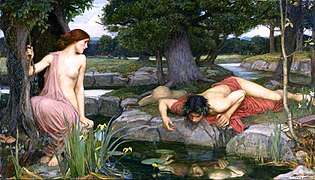 Echo, an Oread (mountain nymph) watches Narcissus in this 1903 painting of Echo and Narcissus by John William Waterhouse.
Echo, an Oread (mountain nymph) watches Narcissus in this 1903 painting of Echo and Narcissus by John William Waterhouse.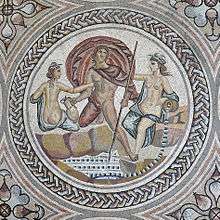
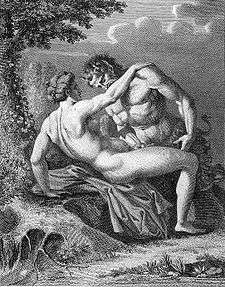 Public sex between a nymph and Satyr. A sketch of Agostino Carracci.
Public sex between a nymph and Satyr. A sketch of Agostino Carracci.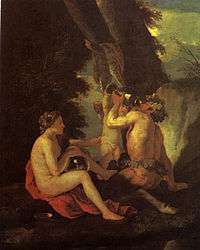 Nymphe et satyr - Nicolas Poussin - Musée Pouchkine Moscou
Nymphe et satyr - Nicolas Poussin - Musée Pouchkine Moscou- Nymphe et Saty (Alexandre Cabanel) 1860
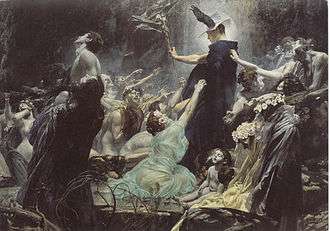 Adolf Hirémy-Hirschl, The Souls of Acheron (1898).
Adolf Hirémy-Hirschl, The Souls of Acheron (1898).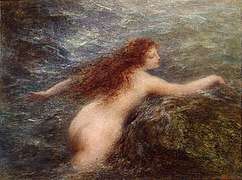
 The Pleiades (1885) by Elihu Vedder.
The Pleiades (1885) by Elihu Vedder.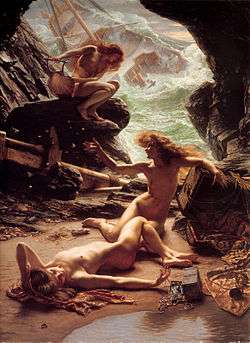
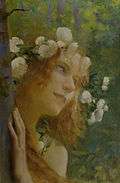 Nymphe by Gaston Bussière
Nymphe by Gaston Bussière- Fight between Nymph and Satyr, Naples National Archaeological Museum.
 A Sleeping Nymph Watched by a Shepherd by Angelica Kauffman, about 1780, (V&A Museum no. 23-1886)
A Sleeping Nymph Watched by a Shepherd by Angelica Kauffman, about 1780, (V&A Museum no. 23-1886)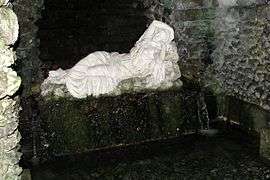 The statue of a sleeping nymph in a grotto at Stourhead, England.
The statue of a sleeping nymph in a grotto at Stourhead, England.
See also
References
- ↑ But see Jennifer Larson, "Handmaidens of Artemis?", The Classical Journal 92.3 (February 1997), pp. 249–257.
- ↑ first published in Θεοτοκάριον μικρόν, Athens (1905).
- ↑ Lawson, John Cuthbert (1910). Modern Greek Folklore and Ancient Greek Religion (1st ed.). Cambridge: Cambridge University Press. p. 131.
- ↑ "heathen Artemis yielded her functions to her own genitive case transformed into Saint Artemidos", as Terrot Reaveley Glover phrased it in discussing the "practical polytheism in the worship of the saints", in Progress in Religion to the Christian Era 1922:107.
- ↑ Tomkinson, John L. (2004). Haunted Greece: Nymphs, Vampires and Other Exotika (1st ed.). Athens: Anagnosis. chapter 3. ISBN 960-88087-0-7.
- ↑ "The Nymph of the Spring". National Gallery of Art. Retrieved 23 September 2016.
- ↑ Stephen John Campbell (2004). The Cabinet of Eros: Renaissance Mythological Painting and the Studiolo of Isabella D'Este. Yale University Press. pp. 95–6. ISBN 0-300-11753-1.
- ↑ Maryan Wynn Ainsworth; Joshua P. Waterman; Dorothy Mahon (2013). German Paintings in the Metropolitan Museum of Art, 1350-1600. Metropolitan Museum of Art. pp. 95–6. ISBN 978-1-58839-487-3.
- ↑ Jay A. Levenson; National Gallery of Art (U.S.) (1991). Circa 1492: Art in the Age of Exploration. Yale University Press. p. 260. ISBN 978-0-300-05167-4.
- ↑ Leonard Barkan (1999). Unearthing the Past: Archaeology and Aesthetics in the Making of Renaissance Culture. Yale University Press. pp. 237–8. ISBN 978-0-300-08911-0.
- ↑ Elisabeth B. MacDougall (January 1994). Fountains, Statues, and Flowers: Studies in Italian Gardens of the Sixteenth and Seventeenth Centuries. Dumbarton Oaks. pp. 37–56. ISBN 978-0-88402-216-9.
- ↑ Kenneth Gross (1992). The Dream of the Moving Statue. Cornell University Press. pp. 170–175. ISBN 0-8014-2702-9.
- ↑ Rose, Herbert Jennings (1959). A Handbook of Greek Mythology (1st ed.). New York: E. P. Dutton. p. 173. ISBN 0-525-47041-7.
- ↑ Orphic Hymn 71.
- ↑ Stephanus of Byzantium s. v. Aōros
- ↑ Pseudo-Apollodorus, Bibliotheca 3. 1. 2
- ↑ Robert Graves. The Greek Myths, section 110 s.v. The Children of Pelops
- ↑ Stephanus of Byzantium s.v. Abrettēnē
- ↑ Schol. ad Pers. Sat. i. 76.
- ↑ Hyginus, Fabulae, 102
- ↑ Pausanias, Description of Greece, 10. 37. 5
- ↑ Suda s. v. Kretheus
- ↑ Stephanus of Byzantium s. v. Krimisa
- ↑ Antoninus Liberalis. Metamorphoses, 22 vs Cerambus
- ↑ Stephanus of Byzantium s. v. Hylleis
- ↑ Robert Graves. The Greek Myths, section 108 s.v. Tantalus
- ↑ Pausanias, Description of Greece, 9. 1. 1
- ↑ William Smith. A Dictionary of Greek and Roman biography and mythology s.v. Myrmex
- ↑ Suda s. v. Nakoleia
- ↑ Pausanias, 9. 35. § 1
- ↑ Antoninus Liberalis, Metamorphoses, 32
Sources
- Burkert, Walter (1985). Greek Religion (1st ed.). Cambridge, MA: Harvard University Press. ISBN 0-674-36281-0.
- Larson, Jennifer Lynn (2001). Greek Nymphs: Myth, Cult, Lore. New York: Oxford University Press. ISBN 0-19-514465-1.
- Lawson, John Cuthbert, Modern Greek Folklore and Ancient Greek Religion, Cambridge University Press, Cambridge, 1910, p. 131
- Nereids
- paleothea.com homepage
- Tomkinson, John L. (2004). Haunted Greece: Nymphs, Vampires and Other Exotika (1st ed.). Athens: Anagnosis. ISBN 960-88087-0-7.

External links
| Wikimedia Commons has media related to Nymphs. |